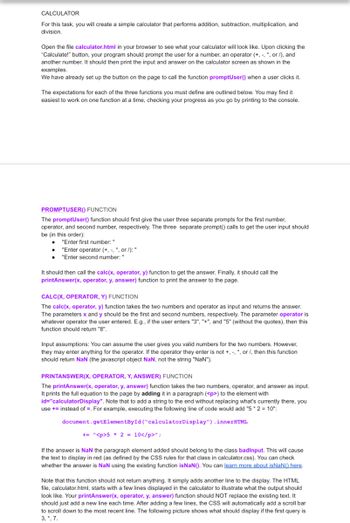
Database System Concepts
7th Edition
ISBN: 9780078022159
Author: Abraham Silberschatz Professor, Henry F. Korth, S. Sudarshan
Publisher: McGraw-Hill Education
expand_more
expand_more
format_list_bulleted
Question
What would this look like in JavaScript + html with if statements not switch

Transcribed Image Text:CALCULATOR
For this task, you will create a simple calculator that performs addition, subtraction, multiplication, and
division.
Open the file calculator.html in your browser to see what your calculator will look like. Upon clicking the
"Calculate!" button, your program should prompt the user for a number, an operator (+, -, *, or /), and
another number. It should then print the input and answer on the calculator screen as shown in the
examples.
We have already set up the button on the page to call the function promptUser() when a user clicks it.
The expectations for each of the three functions you must define are outlined below. You may find it
easiest to work on one function at a time, checking your progress as you go by printing to the console.
PROMPTUSER() FUNCTION
The promptUser() function should first give the user three separate prompts for the first number,
operator, and second number, respectively. The three separate prompt() calls to get the user input should
be (in this order):
●
"Enter first number: "
"Enter operator (+,-,*, or /): "
"Enter second number: "
It should then call the calc(x, operator, y) function to get the answer. Finally, it should call the
printAnswer(x, operator, y, answer) function to print the answer to the page.
CALC(X, OPERATOR, Y) FUNCTION
The calc(x, operator, y) function takes the two numbers and operator as input and returns the answer.
The parameters x and y should be the first and second numbers, respectively. The parameter operator is
whatever operator the user entered. E.g., if the user enters "3", "+", and "5" (without the quotes), then this
function should return "8".
Input assumptions: You can assume the user gives you valid numbers for the two numbers. However,
they may enter anything for the operator. If the operator they enter is not +, -, *, or /, then this function
should return NaN (the javascript object NaN, not the string "NaN").
PRINTANSWER(X, OPERATOR, Y, ANSWER) FUNCTION
The printAnswer(x, operator, y, answer) function takes the two numbers, operator, and answer as input.
It prints the full equation to the page by adding it in a paragraph (<p>) to the element with
id="calculatorDisplay". Note that to add a string to the end without replacing what's currently there, you
use + instead of . For example, executing the following line of code would add "5*2= 10":
document.getElementById("calculator Display") .innerHTML
+= "<p>5 * 2 = 10</p>";
If the answer is NaN the paragraph element added should belong to the class badinput. This will cause
the text to display in red (as defined by the CSS rules for that class in calculator.css). You can check
whether the answer is NaN using the existing function isNaN(). You can learn more about isNaN() here.
Note that this function should not return anything. It simply adds another line to the display. The HTML
file, calculator.html, starts with a few lines displayed in the calculator to illustrate what the output should
look like. Your printAnswer(x, operator, y, answer) function should NOT replace the existing text. It
should just add a new line each time. After adding a few lines, the CSS will automatically add a scroll bar
to scroll down to the most recent line. The following picture shows what should display if the first query is
3, *, 7.
Expert Solution
This question has been solved!
Explore an expertly crafted, step-by-step solution for a thorough understanding of key concepts.
Step by stepSolved in 4 steps with 1 images

Knowledge Booster
Learn more about
Need a deep-dive on the concept behind this application? Look no further. Learn more about this topic, computer-science and related others by exploring similar questions and additional content below.Similar questions
- Write a program in perl to print the smile emoji using v strings.arrow_forwardSolve this using javascript I have 2 strings, var string1 = "1,3,5,7,9,11,13"andvar string2 = "4,8,5,12,13" I want to compare the similarities of two strings. The output should be: 5,13arrow_forwardWrite a multiline string in JavaScript without using template literals and print this string also in multiple linearrow_forward
Recommended textbooks for you
 Database System ConceptsComputer ScienceISBN:9780078022159Author:Abraham Silberschatz Professor, Henry F. Korth, S. SudarshanPublisher:McGraw-Hill Education
Database System ConceptsComputer ScienceISBN:9780078022159Author:Abraham Silberschatz Professor, Henry F. Korth, S. SudarshanPublisher:McGraw-Hill Education Starting Out with Python (4th Edition)Computer ScienceISBN:9780134444321Author:Tony GaddisPublisher:PEARSON
Starting Out with Python (4th Edition)Computer ScienceISBN:9780134444321Author:Tony GaddisPublisher:PEARSON Digital Fundamentals (11th Edition)Computer ScienceISBN:9780132737968Author:Thomas L. FloydPublisher:PEARSON
Digital Fundamentals (11th Edition)Computer ScienceISBN:9780132737968Author:Thomas L. FloydPublisher:PEARSON C How to Program (8th Edition)Computer ScienceISBN:9780133976892Author:Paul J. Deitel, Harvey DeitelPublisher:PEARSON
C How to Program (8th Edition)Computer ScienceISBN:9780133976892Author:Paul J. Deitel, Harvey DeitelPublisher:PEARSON Database Systems: Design, Implementation, & Manag...Computer ScienceISBN:9781337627900Author:Carlos Coronel, Steven MorrisPublisher:Cengage Learning
Database Systems: Design, Implementation, & Manag...Computer ScienceISBN:9781337627900Author:Carlos Coronel, Steven MorrisPublisher:Cengage Learning Programmable Logic ControllersComputer ScienceISBN:9780073373843Author:Frank D. PetruzellaPublisher:McGraw-Hill Education
Programmable Logic ControllersComputer ScienceISBN:9780073373843Author:Frank D. PetruzellaPublisher:McGraw-Hill Education

Database System Concepts
Computer Science
ISBN:9780078022159
Author:Abraham Silberschatz Professor, Henry F. Korth, S. Sudarshan
Publisher:McGraw-Hill Education

Starting Out with Python (4th Edition)
Computer Science
ISBN:9780134444321
Author:Tony Gaddis
Publisher:PEARSON

Digital Fundamentals (11th Edition)
Computer Science
ISBN:9780132737968
Author:Thomas L. Floyd
Publisher:PEARSON

C How to Program (8th Edition)
Computer Science
ISBN:9780133976892
Author:Paul J. Deitel, Harvey Deitel
Publisher:PEARSON

Database Systems: Design, Implementation, & Manag...
Computer Science
ISBN:9781337627900
Author:Carlos Coronel, Steven Morris
Publisher:Cengage Learning

Programmable Logic Controllers
Computer Science
ISBN:9780073373843
Author:Frank D. Petruzella
Publisher:McGraw-Hill Education